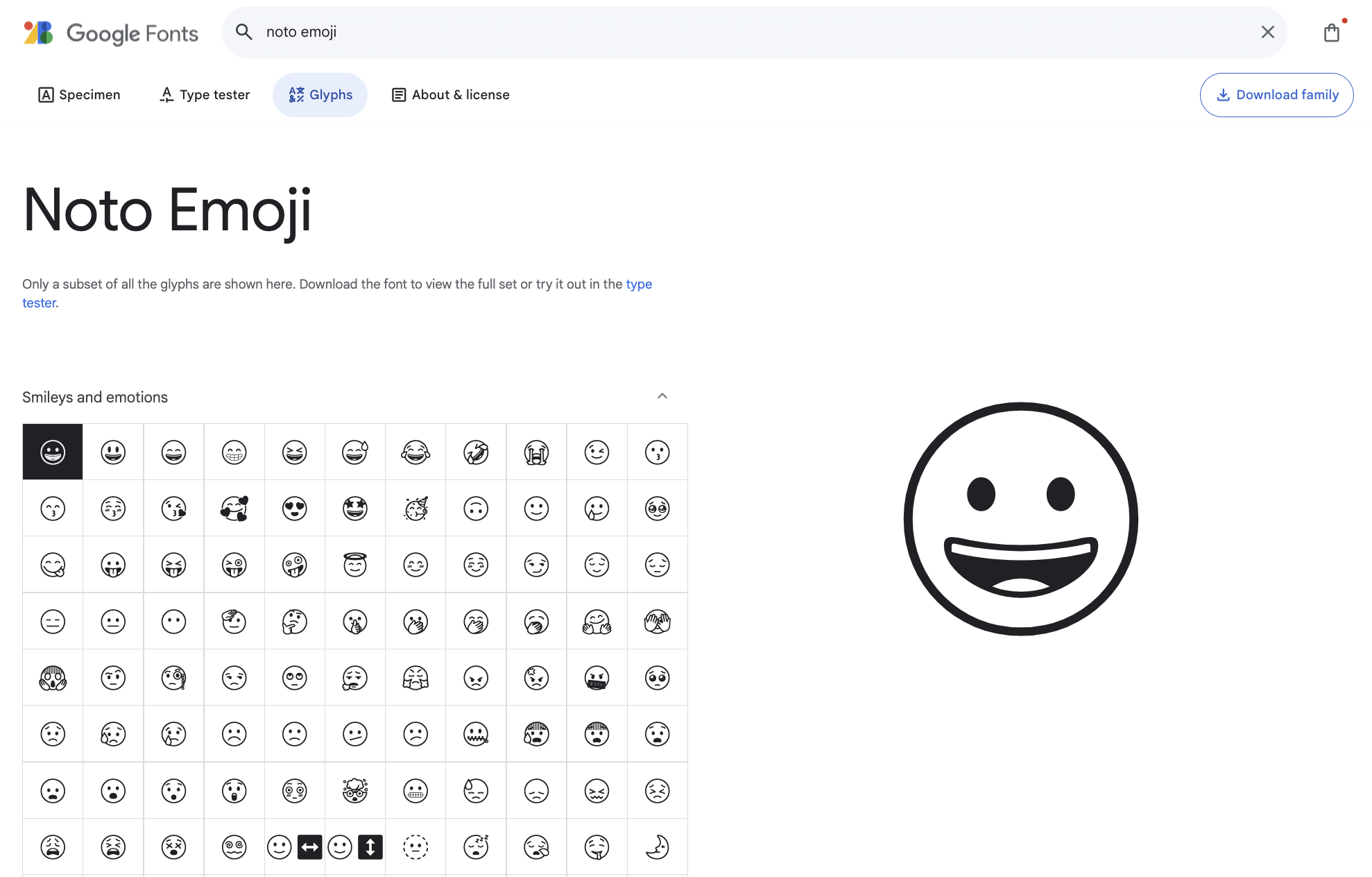Google Fonts
METADATA file
nerd google/fonts repository explained
Table of contents
- History
- Generation
- Description of Keys
History
This documentation was initiated by Adam Twardoch as a community contributor in 2015, and updated by Dave Crossland as a member of the Google Fonts team in 2020. It is provided so that other font distributors (webfont providers or font package maintainers) can better use the library repo repository structure.
This metadata is used specifically by Google Fonts for organization and display on the Google Fonts website. It may be useful for others to be able to make sense of the metadata files.
Generation
The file can be partially generated by the gftools add-font script and gftools packager:
gftools add-font path/to/google/fonts/ofl/fontdirname
The file uses UTF-8 encoding.
Below are two examples of METADATA.pb files: the first for a family of static font files, and the second for a family with variable font files, followed by a brief description of each key and possible values.
Example Static Fonts Family
name: "Example Sans"
designer: "Firstname Lastname, Person Two, Person Three"
license: "OFL"
category: "SANS_SERIF"
date_added: "2021-09-30"
fonts {
name: "Example Sans"
style: "normal"
weight: 400
filename: "ExampleSans-Regular.ttf"
post_script_name: "ExampleSans-Regular"
full_name: "Example Sans Regular"
copyright: "Copyright 2021 The Example Sans Project Authors (github.com/username/example-sans)"
}
fonts {
name: "Example Sans"
style: "italic"
weight: 400
filename: "ExampleSans-Italic.ttf"
post_script_name: "ExampleSans-Italic"
full_name: "Example Sans Italic"
copyright: "Copyright 2021 The Example Sans Project Authors (github.com/username/example-sans)"
}
subsets: "arabic"
subsets: "latin"
subsets: "latin-ext"
subsets: "menu"
subsets: "vietnamese"
primary_script: "Arab"
source {
repository_url: "https://github.com/username/example-sans"
commit: "d9098c0a72125d411dbb225a2e5a61dc15265ffc"
}
minisite_url: "https://myfontwebsite.com"
stroke: "SANS_SERIF"
Example Variable Fonts Family
name: "Example Serif"
designer: "Foundry, Person One Firstname Lastname, Person Two, Person Three"
license: "OFL"
category: "MONOSPACE"
date_added: "2021-09-30"
fonts {
name: "Example Serif"
style: "normal"
weight: 300
filename: "ExampleSerif[opsz,wght].ttf"
post_script_name: "ExampleSerif-Light"
full_name: "Example Serif Light"
copyright: "Copyright 2021 The Example Sans Project Authors (github.com/username/example-serif)"
}
fonts {
name: "Example Serif"
style: "italic"
weight: 300
filename: "ExampleSerif-Italic[opsz,wght].ttf"
post_script_name: "ExampleSerif-LightItalic"
full_name: "Example Serif Light Italic"
copyright: "Copyright 2021 The Example Sans Project Authors (github.com/username/example-serif)"
}
subsets: "latin"
subsets: "latin-ext"
subsets: "menu"
subsets: "vietnamese"
axes {
tag: "wght"
min_value: 300.0
max_value: 700.0
}
axes {
tag: "opsz"
min_value: 10
max_value: 144
}
registry_default_overrides {
key: "opsz"
value: 24
}
source {
repository_url: "https://github.com/MyAccount/MyProject"
files {
source_file: "OFL.txt"
dest_file: "OFL.txt"
}
files {
source_file: "fonts/variable/FontName.ttf"
dest_file: "FontName.ttf"
}
files {
source_file: "documentation/article/ARTICLE.en_us.html"
dest_file: "article/ARTICLE.en_us.html"
}
files {
source_file: "documentation/about/font-image1.png"
dest_file: "arti/font-image1.png"
}
branch: "main"
}
minisite_url: "https://myfontwebsite.com"
stroke: "SERIF"
classifications: "MONOSPACE"
primary_script: "Gujr"
Description of Keys
Most top-level keys provide unique information which is generally not derived from or matching with data inside the font files themselves. Each top-level field can only occur once in the file. The order of the keys does not strictly matter, but the order in this example is typical and is maintained when possible to avoid noisy diff comparisons.
name
Family name used to call the family’s fonts from the Google Fonts API, and shown in the catalog fonts.google.com.
Example: name: "Playpen Sans"
date_added
Date in YYYY-MM-DD format that the font was added to Google Fonts. It is used to order the front page of the GF catalog, both obviously the “date added” sort mode, and also the default “trending mode.”
Once pushed to production, updating this date is generally not allowed, although exceptions can be made in limited cases.
Example: date_added: "2021-09-30"
designer
The full name of the type designers or foundries who designed the fonts. The order in which the names are listed here will determine the order of appearance in the About section of the font’s specimen page (see below).
Each designer listed needs to have an entry in the library repo /catalog/designers tree; and each one needs to match a string in the designer key of info.pb files there.
Examples:
designer: "Principal Designer, Contributor, Contributor"— In 2016 the catalog UI added a feature to show several named contributors on each font family ‘About’ section of the specimen page, where the value of this key is a comma separated list, and the first item in the list is shown the credit “Principal Design”. See the following examples: Rubik, Castoro, Pacificodesigner: "Anja Meiners"— An individual’s name is preferred; typically there is an individual who is the principle designer of the typeface family, even if they are no longer the primary maintainer of the projectdesigner: "TypeTogether"— Sometimes, a formal organization designs a family and occupies the principal designer position. Then, the individual names of the credited designers followdesigner: "Huerta Tipográfica"— Non-ASCII characters are supported as UTF-8
license
Declares the license of the fonts in the family. It can be one of three possible values, although all new fonts added are expected to be licensed as OFL:
license: "APACHE2"license: "OFL"license: "UFL"
category
Typographic classifications, one of 5 possible values:
category: "SERIF"category: "SANS_SERIF"category: "DISPLAY"category: "HANDWRITING"category: "MONOSPACE"
In 2023, the category field was augmented with two new fields called stroke and classifications. The category field will continue to exist with no changes to its semantics. We are keeping the category field as-is because Google products like Workspace and Ads use it, and we don’t want to affect those products.
This key is deprecated in the API (cf. below Stroke and Classification), but still mandatory to fill up in METADATA.pb
fonts
Dictionaries with information specific to each font file in the family. The values in this section typically match those inside the font files. Example:
fonts {
name: "Playpen Sans"
style: "normal"
weight: 400
filename: "PlaypenSans[wght].ttf"
post_script_name: "PlaypenSans-Regular"
full_name: "Playpen Sans Regular"
copyright: "Copyright 2023 The Playpen Sans Project Authors (https://github.com/TypeTogether/Playpen-Sans)"
}
fonts — name
Family name used to call the font from the Google Fonts API. This must match the name key used at the top level.
This typically matches the font file’s name table ID 16 — or, if that does not exist, ID 1. If multiple ID 16s or 1s exist, they must match.
Example: name: "Playpen Sans"
fonts — style
Value of the CSS font-style property served by Google Fonts. One of 2 possible values:
style: "normal"style: "italic"
Styles marked as normal in the family METADATA file refers to any upright styles, and italic refers to any style-linked italic styles.
fonts — weight
Value of the CSS font-weight property served by Google Fonts. For families offered as static fonts, this will be one of 9 possible values:
"weight": 100"weight": 200"weight": 300"weight": 400"weight": 500"weight": 600"weight": 700"weight": 800"weight": 900
Typically this matches the value of usWeightClass in the font file’s OS/2 table.
For variable fonts, this will be one of the 9 possible values that corresponds to the glyf table outline design.
fonts — filename
The font filename. Example: "filename": "PlaypenSans[wght].ttf"
There is a “canonical” naming scheme for font filenames in the Google Fonts library.
For static fonts the pattern is $family-$style.ttf and the allowed values are as follows; These filenames are case sensitive, unlike the default file system of macOS, so Semibold is not allowed, and simply renaming it in macOS Finder will not be effective; it needs to be renamed to something with one more/less character, then renamed back to a correct name.
ExampleSans-Thin.ttfExampleSans-ThinItalic.ttfExampleSans-ExtraLight.ttfExampleSans-ExtraLightItalic.ttfExampleSans-Light.ttfExampleSans-LightItalic.ttfExampleSans-Regular.ttfExampleSans-Italic.ttfExampleSans-Medium.ttfExampleSans-MediumItalic.ttfExampleSans-SemiBold.ttfExampleSans-SemiBoldItalic.ttfExampleSans-Bold.ttfExampleSans-BoldItalic.ttfExampleSans-ExtraBold.ttfExampleSans-ExtraBoldItalic.ttfExampleSans-Black.ttfExampleSans-BlackItalic.ttf
For variable fonts, the naming scheme is the family name, then an alphabetically sorted, comma separated, list of axes within square brackets. If the family has Italic styles in a second file, then the -Italic particle is appended to the family name.
ExampleSans[wdth,wght].ttfExampleSans-Italic[wdth,wght].ttf
fonts — post_script_name
Value of the font file’s name table ID 6. If multiple ID 6s exist, they must match. Example: post_script_name: "PlaypenSans-Regular"
Typically this matches the stem of the filename.
fonts — full_name
Value of the font file’s name table ID 4. If multiple ID 4s exist, they must match. Example: full_name: "Playpen Sans Regular"
fonts — copyright
Copyright notice. Example: copyright: "Copyright 2023 The Playpen Sans Project Authors (https://github.com/TypeTogether/Playpen-Sans)"
Typically this matches the value of the copyright notice in the first lines of the license file. It also matches the font file name table ID 0. If multiple ID 0s exist, they must match.
subsets
List of all character subsets available in Google Fonts API for the given font family. They are described as languages, but they are actually script sets.
These subsets are defined in GF Subsets repo (with the exception of the menu subset).
The menu subset is the characters of the font family name (defined above) and is used in font picker UIs to render the font name in itself. This subset is mandatory for all fonts.
The subsets must be sorted in alphabetical order. The possible values are the same as the available nam files. For example, if a nam file is named chorasmian_unique-glyphs.nam the key in METADATA.pb would be subsets: "chorasmian" (the nam file path without “_unique-glyphs.nam”)
primary script
This key aims to indicate which script the specimen page on Google Fonts should display in priority.
The possible values to enter here must refer to the ID of the specified script’s textprotos from the lang directory in google/fonts repo.
Example:
primary_script: "Arab"
Languages
This key aims to restrict the number of languages shown in a specimen page. It is mandatory in all Noto fonts but not recommended in non-Noto fonts. It can be useful, though, when a font support the glyphs of a specific language only.
Example:
languages: "gu_Gujr" # Gujarati
registry_default_overrides
Override the default value from the Axis Registry. This is required when axis min and max values do not match the registry default, or when the default value differs from the registered default for the axis.
Repeated for each axis.
Contains 2 required child values:
key, with a string value for the 4 character axis tag code.value, asintorfloatvalues.
Example:
registry_default_overrides {
key: "opsz"
value: 18
}
→ Look at Roboto Flex for an example of complex Axis Registry override:
source
Indicates the upstream repo URL and the commit at which the font was taken, this important for versioning, but also to keep a trace back the origin of the font since multiple forks can exist for one project.
If the source is a tagged release, then the source entry should look like this:
source {
repository_url: "https://github.com/username/projectname"
archive_url: "https://github.com/username/projectname/releases/download/v2.200/projectname-2.200.zip"
}
display_name
The display_name key is used when the font name should appear differently on the API. The main use of this key is for families which have abbreviated names as a convention — for example, the Noto CJK families. This is not necessarily clear for the user, so the display_name key is used to display an unabbreviated name on the specimen page.
Example:
font_name: "Noto Sans JP"
display_name: "Noto Sans Japanese"
Another example of use of this key is when the font family name should be written with an hyphen. Indeed, the hyphen is only authorized to separate the family name from the style name; having a font family name with an hyphen would cause a bad file path and postscript name.
Example:
font_name: "Noto Sans PhagsPa"
display_name: "Noto Sans Phags-pa"
minisite_url
This key allows to link a mini website to the font’s specimen page. It will appear on top of the page, under the font name, next to the designer’s name. A minisite_url is expected to be mandatory for all commissioned fonts.
Example:
minisite_url: "https://myfontwebsite.com"
classifications
The classifications field is a complementary field that can be any combination of Handwriting, Display, Monospace, or Symbols, or it can be left unset. So, for example, if a font is Handwriting, Display, and Monospace all at the same time, use all three. If it does not fit into any of those classifications, there is no need to use the field.
classifications: "HANDWRITING"classifications: "DISPLAY"classifications: "MONOSPACE"classifications: "SYMBOLS"
stroke
The stroke field has a single value that is one of SANS_SERIF, SERIF, SLAB_SERIF. It should always be set if one of those options accurately describes the design since some features in the UI only look at the stroke value for some things. Otherwise, if one of the options doesn’t describe the design, it can not be set. Google Fonts Search UI will present stroke and classifications as separate search groups so users can combine them and search, say, for fonts that are Serif and Display.
stroke: "SANS_SERIF"stroke: "SERIF"stroke: "SLAB_SERIF"
sample_text
This key overrides the sample texts provided in the languages texprotos (that you can find in the Lang repository). Therefore, the properties of this key are the same as those in a lang textproto. Use it sparingly only for edge cases that would definitely need to specify a determined sample since this override will make this sample fixed, disabling the possibility of picking different languages on the type-tester section of the Specimen page.
If sample text is given within a sample text group (e.g. poster, specimen, masthead), all fields within that group must be provided.
masthead_fullis a 4 glyphs string (e.g. AaBb) used in a single-script masthead. It is used in specimen masthead component.masthead_partialis a 2 glyphs string (e.g. Aa) that contributes in building a multi-script masthead. It is used in specimen masthead component.stylesis a phrase that has 40-60 chars. Used in presenting the font in different styles in specimen styles component.testeris a phrase that has 60-90 chars. It is used in presenting the font in GF catalog specimen type tester component.
Poster samples are used in presenting the font in GF catalog specimen poster component. The poster module has 3 different strings shown in 3 different styles. A sm, md, and lg string is needed for each of the three rows in the poster. The poster group is only used in Noto fonts.
poster_smis a phrase that has 10-15 chars.poster_mdis a phrase that has 8-12 chars.poster_lgis a word that has 3-8 chars.
Specimen samples are used as type ramp samples. The <nn> indicates the rendering size.
specimen_48is a sentence that has 60-70 chars.specimen_36is a paragraph that has 100-120 chars.specimen_32is a paragraph that has 140-180 chars.specimen_21is a passage that has 300-500 chars.specimen_16is a passage that has 550-750 chars.
Example:
sample_text {
masthead_full: "ᜀᜅᜎᜑ"
masthead_partial: "ᜆᜂ"
styles: "ᜀᜅ᜔ ᜎᜑᜆ᜔ ᜅ᜔ ᜆᜂᜌ᜔ ᜁᜐᜒᜈᜒᜎᜅ᜔ ᜈ ᜋᜎᜌ ᜀᜆ᜔ ᜉᜈ᜔ᜆᜌ᜔ᜉᜈ᜔ᜆᜌ᜔ ᜐ ᜃᜇᜅᜎᜈ᜔"
tester: "ᜀᜅ᜔ ᜎᜑᜆ᜔ ᜅ᜔ ᜆᜂᜌ᜔ ᜁᜐᜒᜈᜒᜎᜅ᜔ ᜈ ᜋᜎᜌ ᜀᜆ᜔ ᜉᜈ᜔ᜆᜌ᜔ᜉᜈ᜔ᜆᜌ᜔ ᜐ ᜃᜇᜅᜎᜈ᜔ ᜀᜆ᜔ ᜋ᜔ᜄ ᜃᜇᜉᜆᜈ᜔ ᜐᜒᜎᜌ᜔"
poster_sm: "ᜀᜅ᜔ ᜎᜑᜆ᜔ ᜅ᜔ ᜆᜂᜌ᜔"
poster_md: "ᜀᜅ᜔ ᜎᜑᜆ᜔"
poster_lg: "ᜎᜑᜆ᜔"
specimen_48: "ᜀᜅ᜔ ᜎᜑᜆ᜔ ᜅ᜔ ᜆᜂᜌ᜔ ᜁᜐᜒᜈᜒᜎᜅ᜔ ᜈ ᜋᜎᜌ ᜀᜆ᜔ ᜉᜈ᜔ᜆᜌ᜔ᜉᜈ᜔ᜆᜌ᜔ ᜐ ᜃᜇᜅᜎᜈ᜔ ᜀᜆ᜔ ᜋ᜔ᜄ"
specimen_36: "ᜀᜅ᜔ ᜎᜑᜆ᜔ ᜅ᜔ ᜆᜂᜌ᜔ ᜁᜐᜒᜈᜒᜎᜅ᜔ ᜈ ᜋᜎᜌ ᜀᜆ᜔ ᜉᜈ᜔ᜆᜌ᜔ᜉᜈ᜔ᜆᜌ᜔ ᜐ ᜃᜇᜅᜎᜈ᜔ ᜀᜆ᜔ ᜋ᜔ᜄ ᜃᜇᜉᜆᜈ᜔ ᜐᜒᜎᜌ᜔ ᜉᜒᜈᜄ᜔ᜃᜎᜓᜊᜈ᜔ ᜅ᜔ ᜃᜆ᜔ᜏᜒᜇᜈ᜔ ᜀᜆ᜔ ᜊᜓᜇ᜔ᜑᜒ ᜀᜆ᜔ ᜇᜉᜆ᜔ ᜋᜄ᜔ᜉᜎᜄᜌᜈ᜔ ᜀᜅ᜔ ᜁᜐᜆ᜔ ᜁᜐ ᜐ ᜇᜒᜏ ᜅ᜔ ᜉᜄ᜔ᜃᜃᜉᜆᜒᜇᜈ᜔"
specimen_32: "ᜀᜅ᜔ ᜎᜑᜆ᜔ ᜅ᜔ ᜆᜂᜌ᜔ ᜁᜐᜒᜈᜒᜎᜅ᜔ ᜈ ᜋᜎᜌ ᜀᜆ᜔ ᜉᜈ᜔ᜆᜌ᜔ᜉᜈ᜔ᜆᜌ᜔ ᜐ ᜃᜇᜅᜎᜈ᜔ ᜀᜆ᜔ ᜋ᜔ᜄ ᜃᜇᜉᜆᜈ᜔ ᜐᜒᜎᜌ᜔ ᜉᜒᜈᜄ᜔ᜃᜎᜓᜊᜈ᜔ ᜅ᜔ ᜃᜆ᜔ᜏᜒᜇᜈ᜔ ᜀᜆ᜔ ᜊᜓᜇ᜔ᜑᜒ ᜀᜆ᜔ ᜇᜉᜆ᜔ ᜋᜄ᜔ᜉᜎᜄᜌᜈ᜔ ᜀᜅ᜔ ᜁᜐᜆ᜔ ᜁᜐ ᜐ ᜇᜒᜏ ᜅ᜔ ᜉᜄ᜔ᜃᜃᜉᜆᜒᜇᜈ᜔"
specimen_21: "ᜀᜅ᜔ ᜎᜑᜆ᜔ ᜅ᜔ ᜆᜂᜌ᜔ ᜁᜐᜒᜈᜒᜎᜅ᜔ ᜈ ᜋᜎᜌ ᜀᜆ᜔ ᜉᜈ᜔ᜆᜌ᜔ᜉᜈ᜔ᜆᜌ᜔ ᜐ ᜃᜇᜅᜎᜈ᜔ ᜀᜆ᜔ ᜋ᜔ᜄ ᜃᜇᜉᜆᜈ᜔ ᜐᜒᜎᜌ᜔ ᜉᜒᜈᜄ᜔ᜃᜎᜓᜊᜈ᜔ ᜅ᜔ ᜃᜆ᜔ᜏᜒᜇᜈ᜔ ᜀᜆ᜔ ᜊᜓᜇ᜔ᜑᜒ ᜀᜆ᜔ ᜇᜉᜆ᜔ ᜋᜄ᜔ᜉᜎᜄᜌᜈ᜔ ᜀᜅ᜔ ᜁᜐᜆ᜔ ᜁᜐ ᜐ ᜇᜒᜏ ᜅ᜔ ᜉᜄ᜔ᜃᜃᜉᜆᜒᜇᜈ᜔\nᜀᜅ᜔ ᜎᜑᜆ᜔ ᜅ᜔ ᜆᜂᜌ᜔ ᜁᜐᜒᜈᜒᜎᜅ᜔ ᜈ ᜋᜎᜌ ᜀᜆ᜔ ᜉᜈ᜔ᜆᜌ᜔ᜉᜈ᜔ᜆᜌ᜔ ᜐ ᜃᜇᜅᜎᜈ᜔ ᜀᜆ᜔ ᜋ᜔ᜄ ᜃᜇᜉᜆᜈ᜔ ᜐᜒᜎᜌ᜔ ᜉᜒᜈᜄ᜔ᜃᜎᜓᜊᜈ᜔ ᜅ᜔ ᜃᜆ᜔ᜏᜒᜇᜈ᜔ ᜀᜆ᜔ ᜊᜓᜇ᜔ᜑᜒ ᜀᜆ᜔ ᜇᜉᜆ᜔ ᜋᜄ᜔ᜉᜎᜄᜌᜈ᜔ ᜀᜅ᜔ ᜁᜐᜆ᜔ ᜁᜐ ᜐ ᜇᜒᜏ ᜅ᜔ ᜉᜄ᜔ᜃᜃᜉᜆᜒᜇᜈ᜔\nᜀᜅ᜔ ᜎᜑᜆ᜔ ᜅ᜔ ᜆᜂᜌ᜔ ᜁᜐᜒᜈᜒᜎᜅ᜔ ᜈ ᜋᜎᜌ ᜀᜆ᜔ ᜉᜈ᜔ᜆᜌ᜔ᜉᜈ᜔ᜆᜌ᜔ ᜐ ᜃᜇᜅᜎᜈ᜔ ᜀᜆ᜔ ᜋ᜔ᜄ ᜃᜇᜉᜆᜈ᜔ ᜐᜒᜎᜌ᜔ ᜉᜒᜈᜄ᜔ᜃᜎᜓᜊᜈ᜔ ᜅ᜔ ᜃᜆ᜔ᜏᜒᜇᜈ᜔ ᜀᜆ᜔ ᜊᜓᜇ᜔ᜑᜒ ᜀᜆ᜔ ᜇᜉᜆ᜔ ᜋᜄ᜔ᜉᜎᜄᜌᜈ᜔ ᜀᜅ᜔ ᜁᜐᜆ᜔ ᜁᜐ ᜐ ᜇᜒᜏ ᜅ᜔ ᜉᜄ᜔ᜃᜃᜉᜆᜒᜇᜈ᜔"
specimen_16: "ᜀᜅ᜔ ᜎᜑᜆ᜔ ᜅ᜔ ᜆᜂᜌ᜔ ᜁᜐᜒᜈᜒᜎᜅ᜔ ᜈ ᜋᜎᜌ ᜀᜆ᜔ ᜉᜈ᜔ᜆᜌ᜔ᜉᜈ᜔ᜆᜌ᜔ ᜐ ᜃᜇᜅᜎᜈ᜔ ᜀᜆ᜔ ᜋ᜔ᜄ ᜃᜇᜉᜆᜈ᜔ ᜐᜒᜎᜌ᜔ ᜉᜒᜈᜄ᜔ᜃᜎᜓᜊᜈ᜔ ᜅ᜔ ᜃᜆ᜔ᜏᜒᜇᜈ᜔ ᜀᜆ᜔ ᜊᜓᜇ᜔ᜑᜒ ᜀᜆ᜔ ᜇᜉᜆ᜔ ᜋᜄ᜔ᜉᜎᜄᜌᜈ᜔ ᜀᜅ᜔ ᜁᜐᜆ᜔ ᜁᜐ ᜐ ᜇᜒᜏ ᜅ᜔ ᜉᜄ᜔ᜃᜃᜉᜆᜒᜇᜈ᜔\nᜀᜅ᜔ ᜎᜑᜆ᜔ ᜅ᜔ ᜆᜂᜌ᜔ ᜁᜐᜒᜈᜒᜎᜅ᜔ ᜈ ᜋᜎᜌ ᜀᜆ᜔ ᜉᜈ᜔ᜆᜌ᜔ᜉᜈ᜔ᜆᜌ᜔ ᜐ ᜃᜇᜅᜎᜈ᜔ ᜀᜆ᜔ ᜋ᜔ᜄ ᜃᜇᜉᜆᜈ᜔ ᜐᜒᜎᜌ᜔ ᜉᜒᜈᜄ᜔ᜃᜎᜓᜊᜈ᜔ ᜅ᜔ ᜃᜆ᜔ᜏᜒᜇᜈ᜔ ᜀᜆ᜔ ᜊᜓᜇ᜔ᜑᜒ ᜀᜆ᜔ ᜇᜉᜆ᜔ ᜋᜄ᜔ᜉᜎᜄᜌᜈ᜔ ᜀᜅ᜔ ᜁᜐᜆ᜔ ᜁᜐ ᜐ ᜇᜒᜏ ᜅ᜔ ᜉᜄ᜔ᜃᜃᜉᜆᜒᜇᜈ᜔\nᜀᜅ᜔ ᜎᜑᜆ᜔ ᜅ᜔ ᜆᜂᜌ᜔ ᜁᜐᜒᜈᜒᜎᜅ᜔ ᜈ ᜋᜎᜌ ᜀᜆ᜔ ᜉᜈ᜔ᜆᜌ᜔ᜉᜈ᜔ᜆᜌ᜔ ᜐ ᜃᜇᜅᜎᜈ᜔ ᜀᜆ᜔ ᜋ᜔ᜄ ᜃᜇᜉᜆᜈ᜔ ᜐᜒᜎᜌ᜔ ᜉᜒᜈᜄ᜔ᜃᜎᜓᜊᜈ᜔ ᜅ᜔ ᜃᜆ᜔ᜏᜒᜇᜈ᜔ ᜀᜆ᜔ ᜊᜓᜇ᜔ᜑᜒ ᜀᜆ᜔ ᜇᜉᜆ᜔ ᜋᜄ᜔ᜉᜎᜄᜌᜈ᜔ ᜀᜅ᜔ ᜁᜐᜆ᜔ ᜁᜐ ᜐ ᜇᜒᜏ ᜅ᜔ ᜉᜄ᜔ᜃᜃᜉᜆᜒᜇᜈ᜔\nᜀᜅ᜔ ᜎᜑᜆ᜔ ᜅ᜔ ᜆᜂᜌ᜔ ᜁᜐᜒᜈᜒᜎᜅ᜔ ᜈ ᜋᜎᜌ ᜀᜆ᜔ ᜉᜈ᜔ᜆᜌ᜔ᜉᜈ᜔ᜆᜌ᜔ ᜐ ᜃᜇᜅᜎᜈ᜔ ᜀᜆ᜔ ᜋ᜔ᜄ ᜃᜇᜉᜆᜈ᜔ ᜐᜒᜎᜌ᜔ ᜉᜒᜈᜄ᜔ᜃᜎᜓᜊᜈ᜔ ᜅ᜔ ᜃᜆ᜔ᜏᜒᜇᜈ᜔ ᜀᜆ᜔ ᜊᜓᜇ᜔ᜑᜒ ᜀᜆ᜔ ᜇᜉᜆ᜔ ᜋᜄ᜔ᜉᜎᜄᜌᜈ᜔ ᜀᜅ᜔ ᜁᜐᜆ᜔ ᜁᜐ ᜐ ᜇᜒᜏ ᜅ᜔ ᜉᜄ᜔ᜃᜃᜉᜆᜒᜇᜈ᜔\nᜀᜅ᜔ ᜎᜑᜆ᜔ ᜅ᜔ ᜆᜂᜌ᜔ ᜁᜐᜒᜈᜒᜎᜅ᜔ ᜈ ᜋᜎᜌ ᜀᜆ᜔ ᜉᜈ᜔ᜆᜌ᜔ᜉᜈ᜔ᜆᜌ᜔ ᜐ ᜃᜇᜅᜎᜈ᜔ ᜀᜆ᜔ ᜋ᜔ᜄ ᜃᜇᜉᜆᜈ᜔ ᜐᜒᜎᜌ᜔ ᜉᜒᜈᜄ᜔ᜃᜎᜓᜊᜈ᜔ ᜅ᜔ ᜃᜆ᜔ᜏᜒᜇᜈ᜔ ᜀᜆ᜔ ᜊᜓᜇ᜔ᜑᜒ ᜀᜆ᜔ ᜇᜉᜆ᜔ ᜋᜄ᜔ᜉᜎᜄᜌᜈ᜔ ᜀᜅ᜔ ᜁᜐᜆ᜔ ᜁᜐ ᜐ ᜇᜒᜏ ᜅ᜔ ᜉᜄ᜔ᜃᜃᜉᜆᜒᜇᜈ᜔"
}
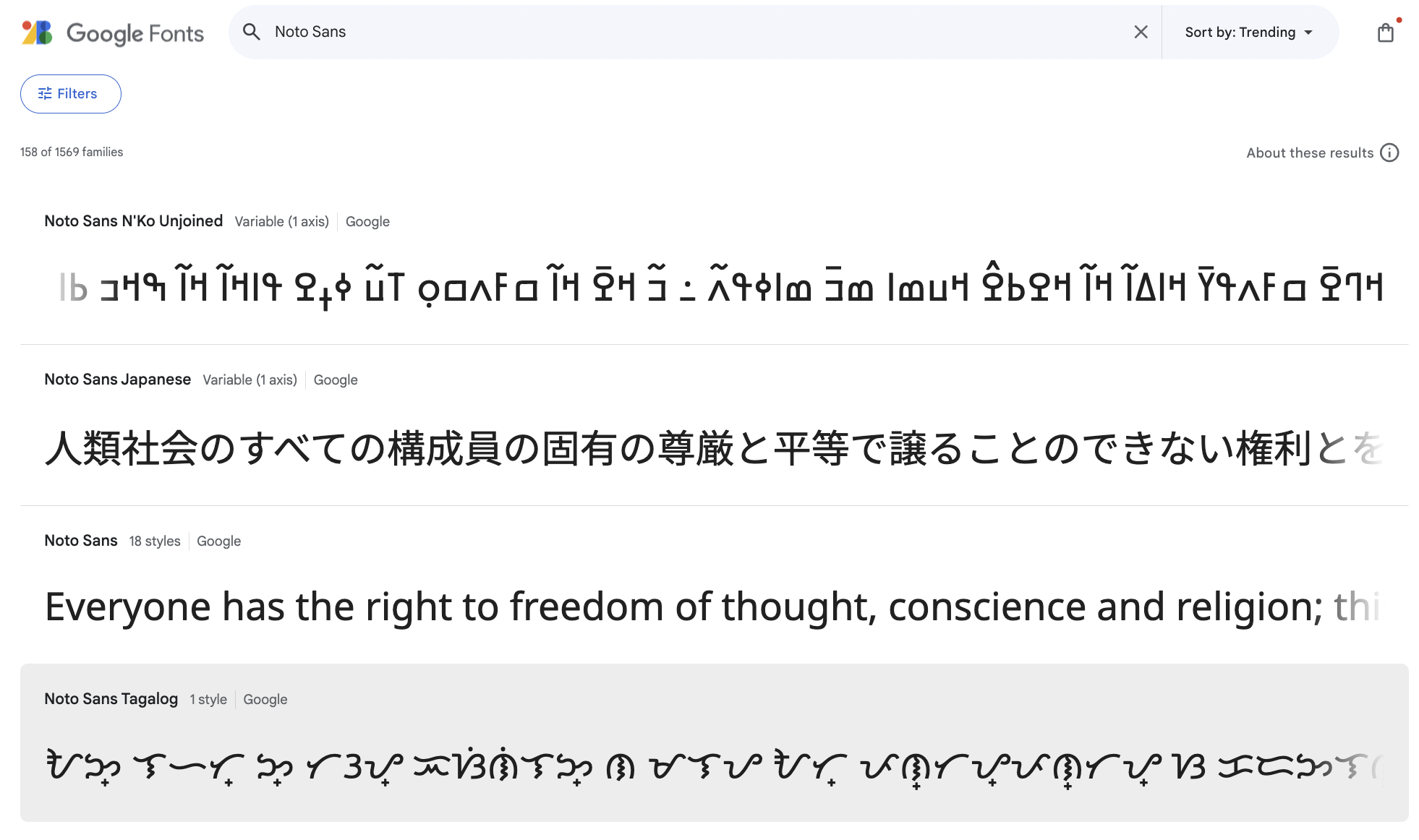
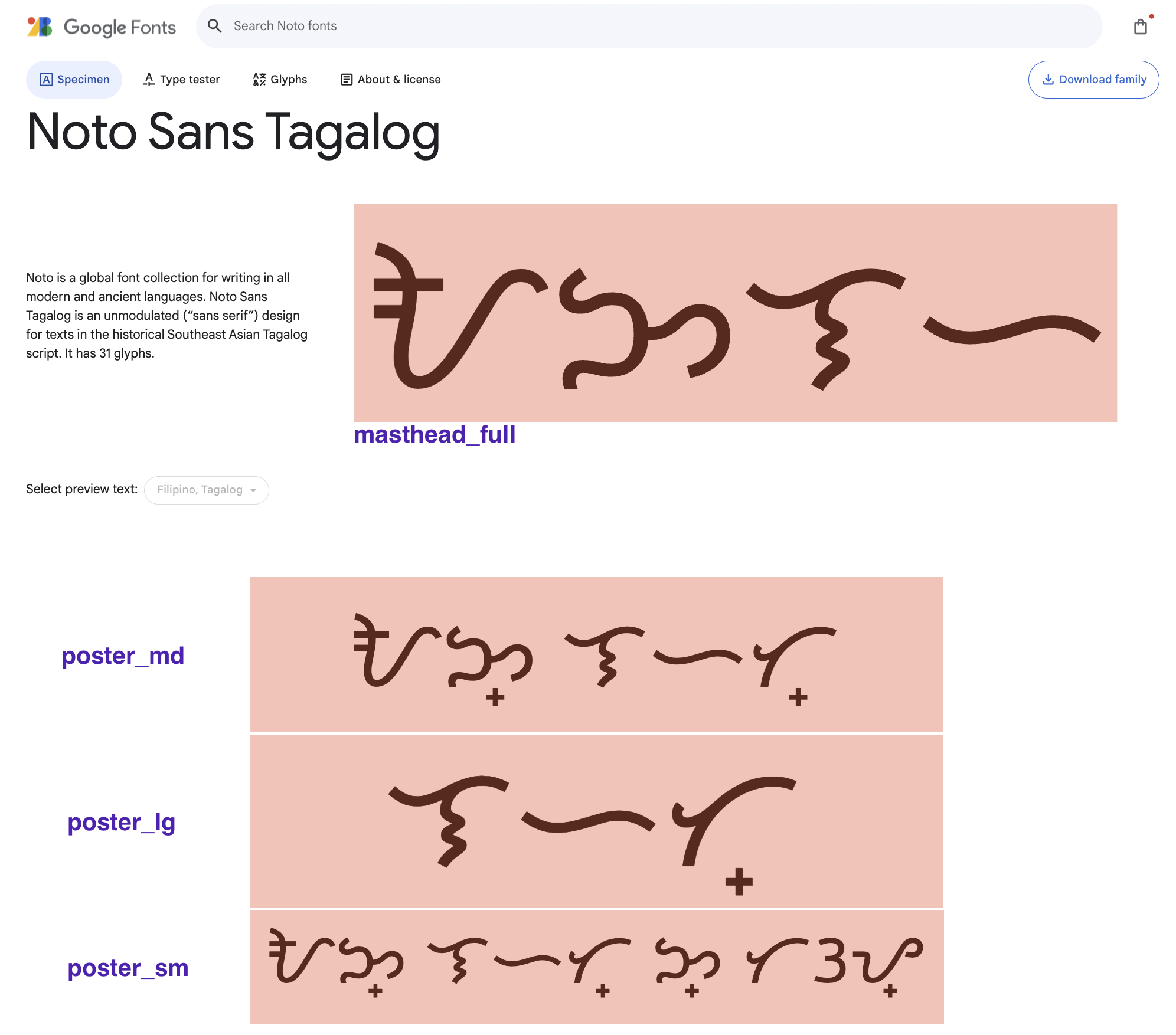

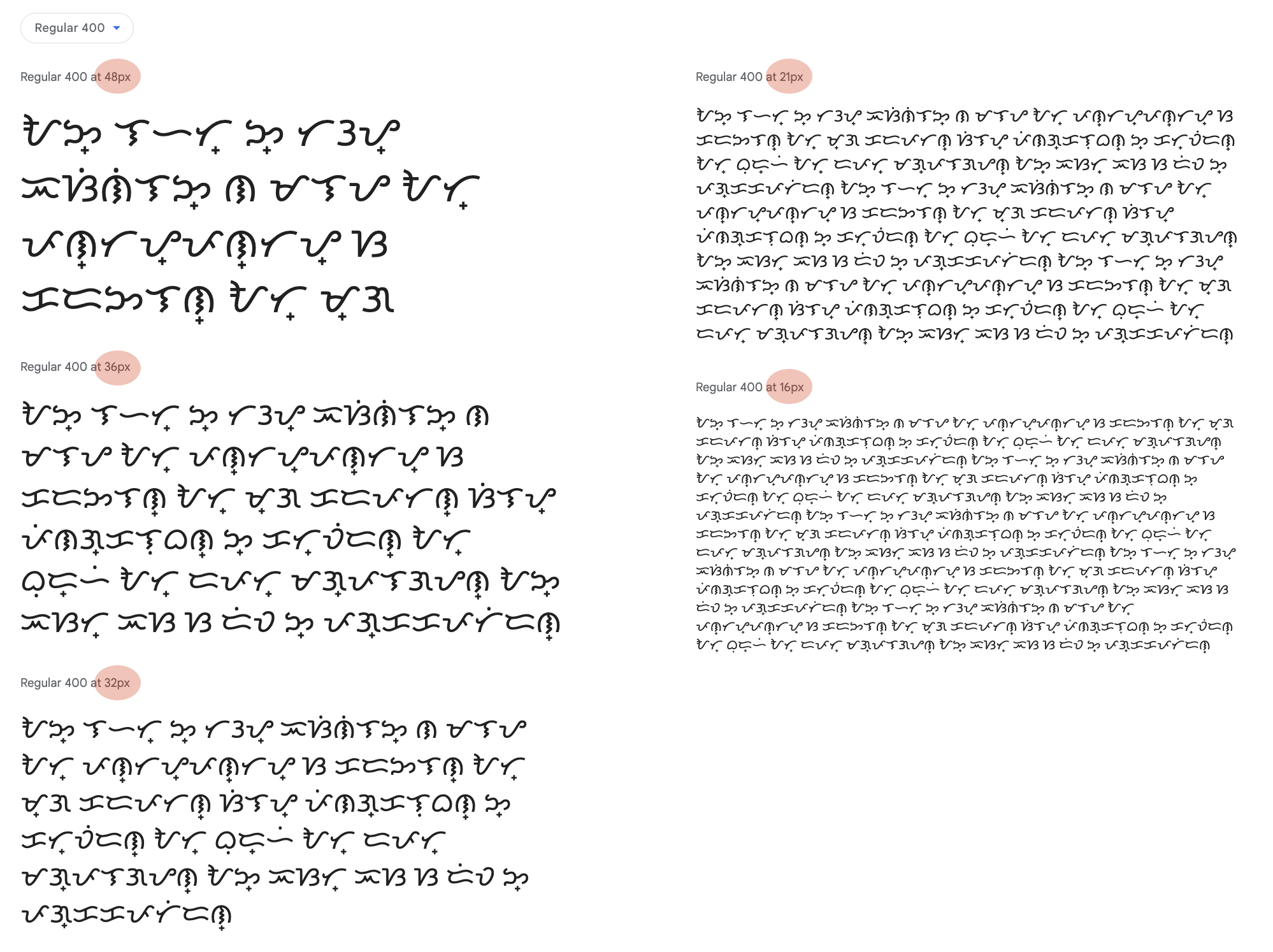
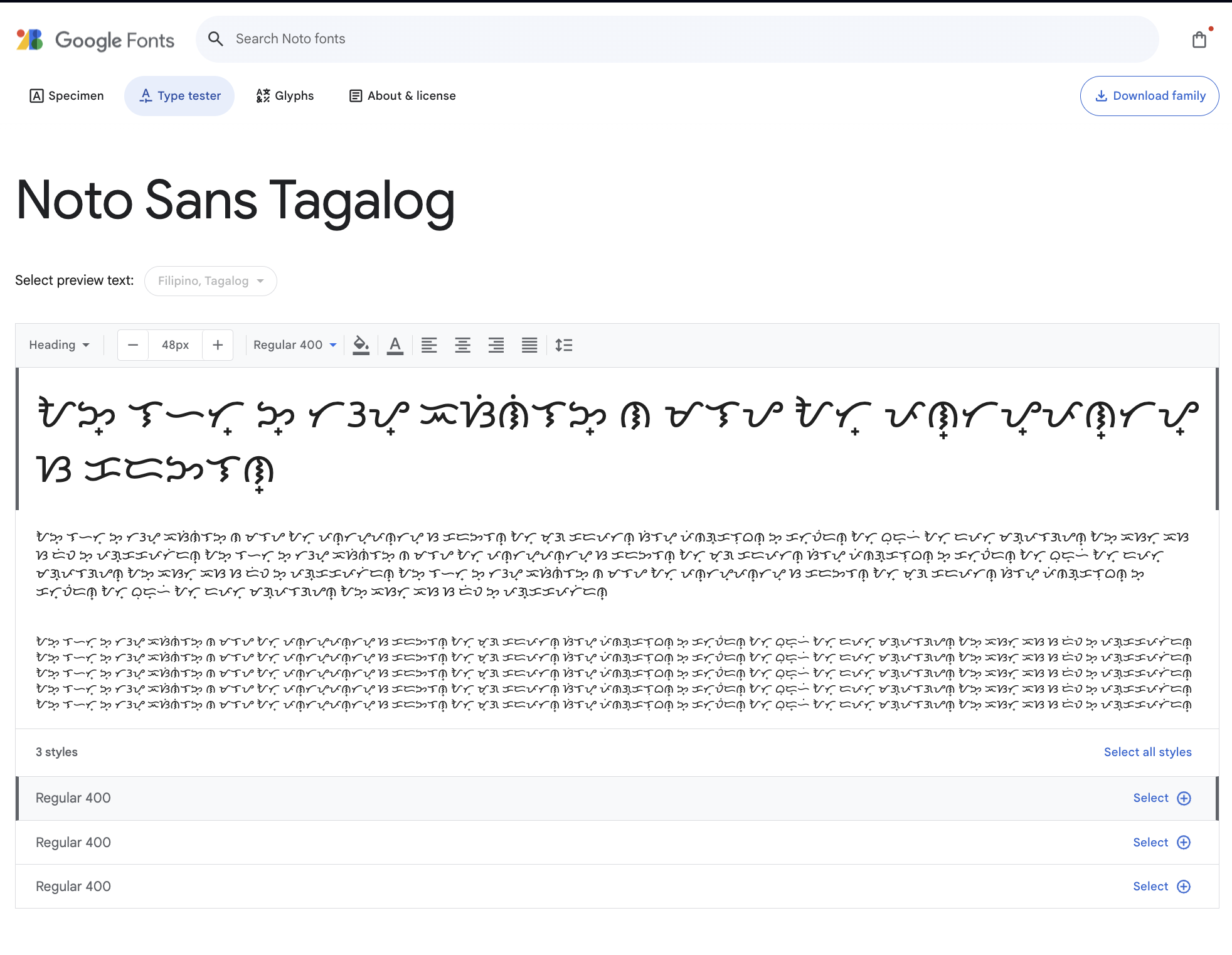
Ordered sample glyphs
This key overrides the Glyphs page on the UI. Example: Noto Emoji. Not recommended to use in other fonts than icon/symbols one.
Example:
ordered_sample_glyphs {
name: "Smileys and emotions"
glyphs: "😀 😃 😄 😁 😆 😅 😂 🤣 😭 😉 😗 😙 😚 😘 🥰 😍 🤩 🥳 🙃 🙂 🥲 🥹 😋 😛 😝 😜 🤪 😇 😊 ☺️ 😏 😌 😔 😑 😐 😶 🫡 🤔 🤫 🫢 🤭 🥱 🤗 🫣 😱 🤨 🧐 😒 🙄 😮💨 😤 😠 😡 🤬 🥺 😟 😥 😢 ☹️ 🙁 🫤 😕 🤐 😰 😨 😧 😦 😮 😯 😲 😳 🤯 😬 😓 😞 😖 😣 😩 😫 😵 😵💫 🙂↔️ 🙂↕️ 🫥 😴 😪 🤤 🌛 🌜 🌚 🌝 🌞 🫠 😶🌫️ 🥴 🥵 🥶 🤢 🤮 🤧 🤒 🤕 😷 🤠 🤑 😎 🤓 🥸 🤥 🤡 👻 💩 👽 🤖 🎃 😈 👿 👹 👺 🔥 💫 ⭐ 🌟 ✨ 💥 💯 💢 💨 💦 🫧 💤 🕳️ 🎉 🎊 🙈 🙉 🙊 😺 😸 😹 😻 😼 😽 🙀 😿 😾 ❤️ 🧡 💛 💚 💙 💜 🤎 🖤 🤍 ♥️ 💘 💝 💖 💗 💓 💞 💕 💌 💟 ❣️ ❤️🩹 💔 ❤️🔥 💋 🫂 👥 👤 🗣️ 👣 🧠 🫀 🫁 🩸 🦠 🦷 🦴 ☠️ 💀 👀 👁️ 👄 🫦 👅 👃 👂 🦻 🦶 🦵 🦿 🦾 💪 👍 👎 👏 🫶 🙌 👐 🤲 🤝 🤜 🤛 ✊ 👊 🫳 🫴 🫱 🫲 🤚 👋 🖐️ ✋ 🖖 🤟 🤘 ✌️ 🤞 🫰 🤙 🤌 🤏 👌 🖕 ☝️ 👆 👇 👉 👈 🫵 ✍️ 🤳 🙏 💅"
}
